Tom Warren takes his Eagle Cap 1160 double slide ice fishing in Alaska. Fire up the snow machine and grab the propane ice auger. It’s time to fish!

A good number of truck camper owners are more or less fair weather campers. If it’s too hot or too cold, they stay home. This doesn’t mean their truck campers can’t handle temperature extremes (they can), but these folks would prefer not to camp in that kind of weather. We fit into this category ourselves.
In direct contrast, other truck camper owners bought their campers specifically because they allow them to camp in the pressing heat and/or freezing cold. They researched motorhomes and trailers and determined those RV types would not be nearly as weather and temperature versatile as a four-wheel drive truck and truck camper. And they were right.
Tom Warren is firmly in this second camp. Living in Big Lake, Alaska just north of Anchorage, Tom loves ice fishing on remote Alaskan lakes for rainbow trout, arctic char, land locked salmon, arctic grayling, burbot and lake trout. As long as temperatures stay above 5 degrees, he takes his Eagle Cap 1160, snow machine, propane-powered ice auger, and ice fishing shelter – and goes fishing!
Just thinking about this probably sent chills through the majority of Truck Camper Magazine’s readership. And you thought you were hearty!
We contacted Tom to find out how he prepares his rig (and himself) to endure these punishing conditions, and to dig into what motivates him to do so. Here’s a hint: Tom loves ice fishing!
How did you first get into ice fishing?
I grew up in Northern Michigan where ice fishing is a popular past time. I also lived in the Upper Peninsula for eight years while stationed at K.I. Sawyer AFB in the Air Force. Ice fishing is very popular up there as well. After Michigan and some overseas and southern stateside assignments, we moved in 1999 to Alaska.
My father and grandfather were really into ice fishing. In fact, my grandfather created his own version of the ice fishing tip-up device that allows ice fisherman to fish unmanned holes.
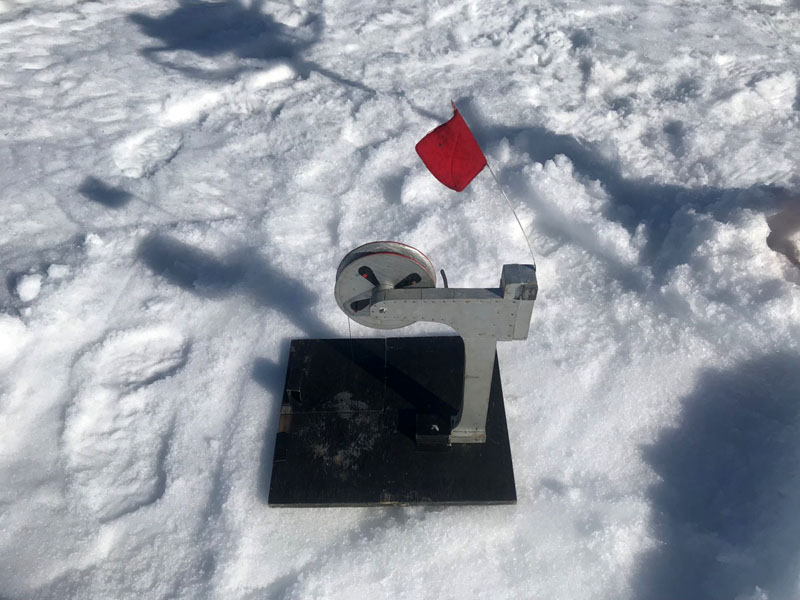
Above: Ice fishing tip-up indicating a fish was caught
The tip-up device is essentially a flexible flagpole that’s a lot like a dip stick from a vehicle. Attached to it is a red or orange flag. When a fish takes the bait, it turns the reel and makes the flag pop up.
In some places you can fish multiple lines. We are allowed five lines up here in Alaska for northern pike. With my grandfather’s tip-up, I can have four unmanned holes and actively fish in one.
That’s neat. How do you make the holes in the ice?
I use an auger that drills down into the ice. They are mostly motorized and 10-inches is about the maximum size.
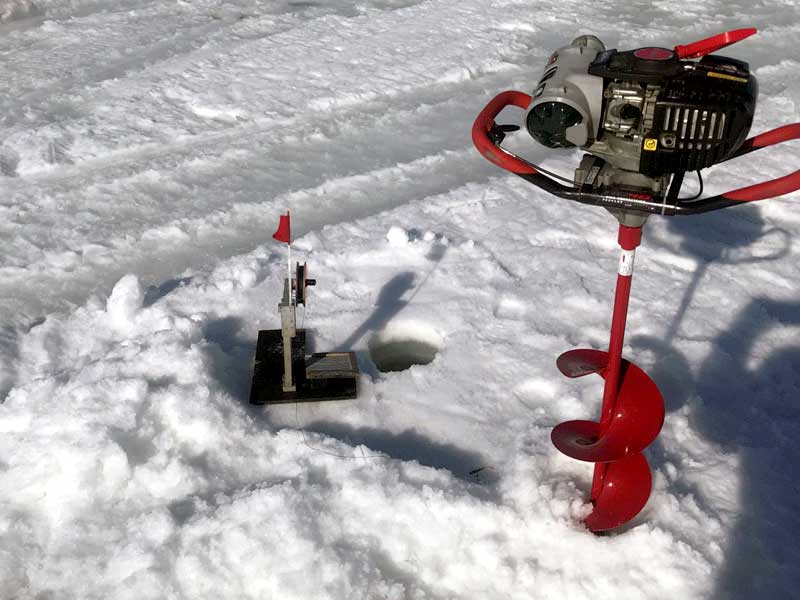
Above: The Eskimo propane auger (right) makes a 10-inch diameter hole (center)
There is a motor up top, handle bars, and a thumb throttle. I have owned a motorized auger for 15 years. Prior to that, I used a hand crank.
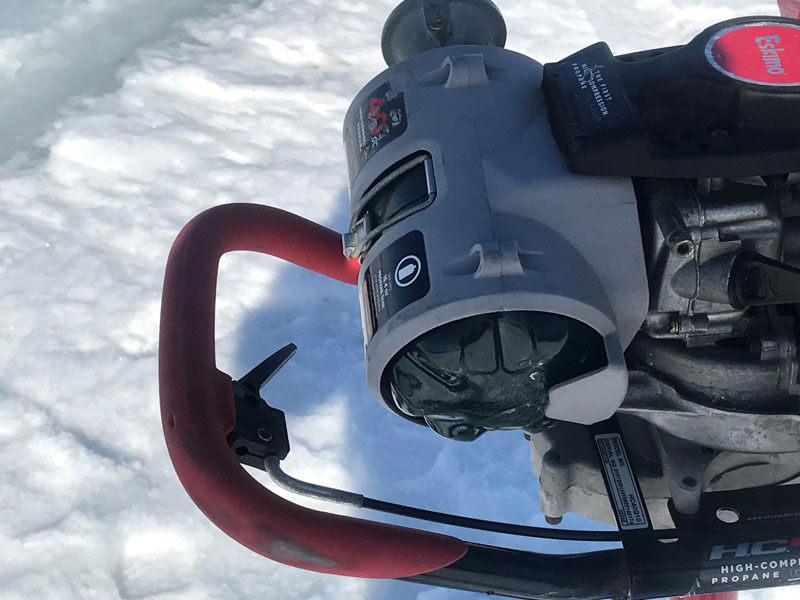
Above: The small propane bottle for the auger
I have a propane powered Eskimo ice auger because it’s cleaner, quieter, and easier to use. I can use it inside my ice shelter and not have obnoxious gas fumes. I think Eskimo makes the best ice augers. They also build shelters, sleds, and more.
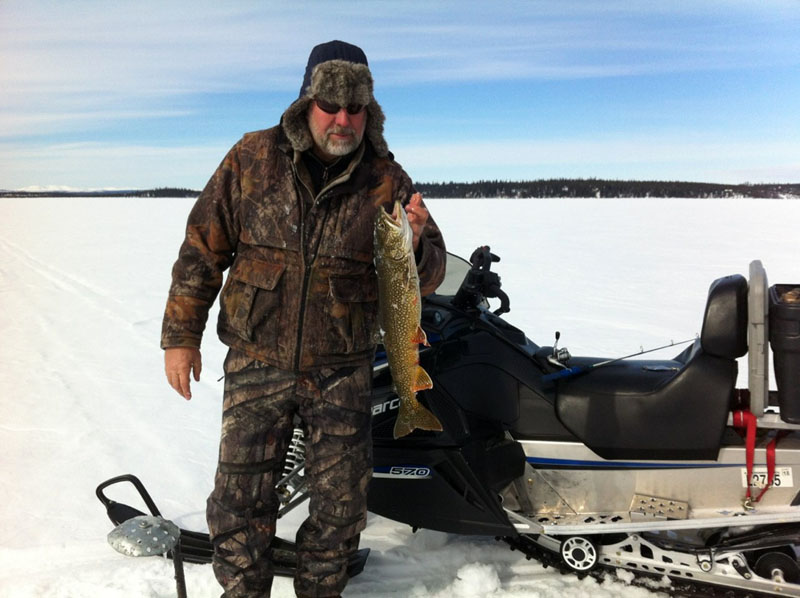
Above: Tom with a lake trout on Lake Louise
On our sonar fish finders, we can then see the fish come in. Mainly I am looking for lake trout because they are bigger and a little bit easier to target. We do catch smaller rainbow trout. They are fun to catch and plentiful.
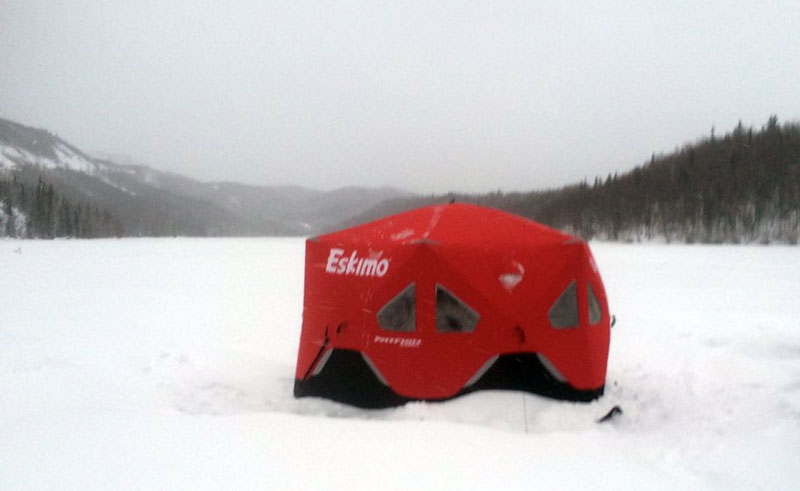
This is starting to sound more involved than we might have presumed. What else do you need other than a propane auger and a sonar fish finder?
I take along all of my fishing gear including short rods and tackle. I also bring along a portable ice shelter with a heater inside.
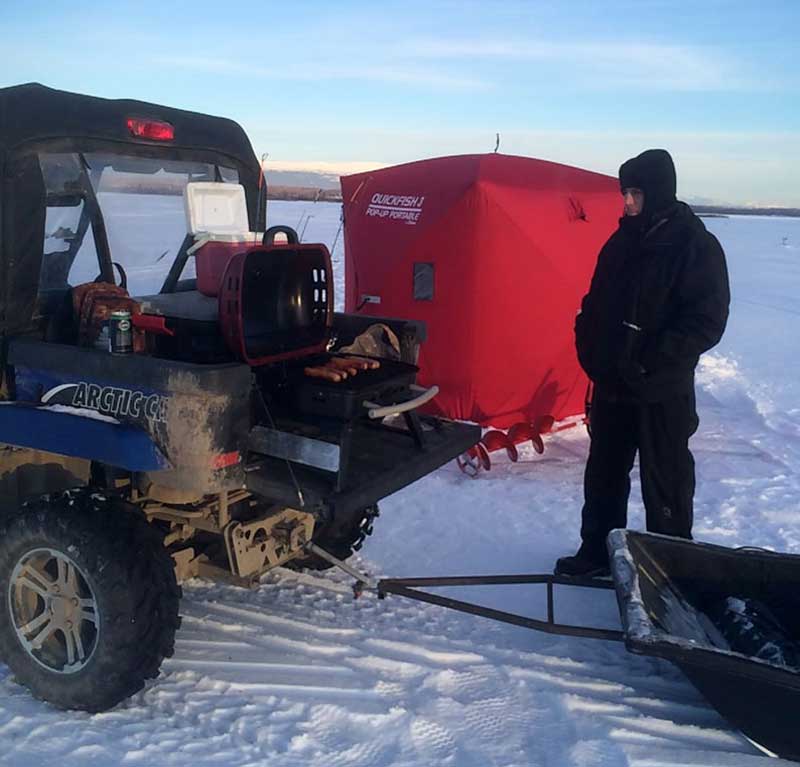
Above: Cooking lunch while out ice fishing
Isn’t it somewhat dangerous to walk out into the ice?
It can be. When there is a lot of snow on top of the ice, the pressure forces the water through edges and cracks the ice. We get overflow and that’s a hazard to look out for; not so much for falling through, but for getting stuck.
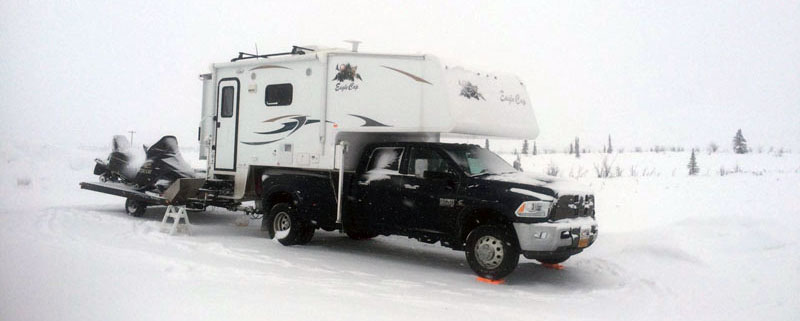
Above: Camping along the Glenn Highway, ice fishing equipment in tow
How does your Eagle Cap 1160 fit into your ice fishing hobby?
Early in the season, I’ll watch the weather. If it only gets down to 5 degrees, I’ll use my truck camper. March and April is really the greatest time to ice fish and dry camp.
During the early spring the ice is thick, we get longer days, and the sun is shining. It’s great to take my truck camper because the hard part of winter is over.
Earlier in the season it’s too cold for the camper. Sometimes when I’m ice fishing it’s 40 below at night.
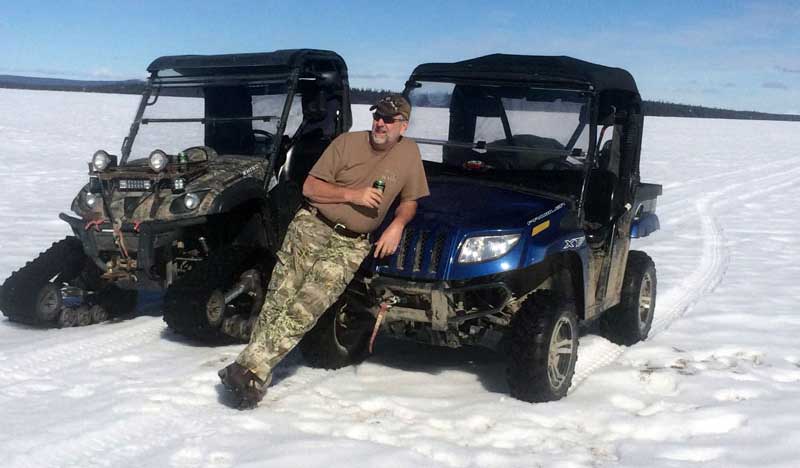
Above: When it’s a bit warmer Tom brings the side-by-sides instead of the snow mobile
That’s insane. What’s the coldest you’ve camped in with your truck camper?
The coldest has been five degrees. I have not done anything special to the camper to make it better insulated for the cold. We run the onboard furnace and sometimes run the electric heater off our onboard generator. That can get noisy, so I also have a 2000-watt Honda EU2000i generator which runs for a long time.
I sit the Honda on foam board because (in the cold temperatures) the oil will get stiff, the low oil indicator will go on, and the generator will shut it down. We also put a cover over the Honda in cold weather and haven’t had any trouble since.
I also bring a ladder to keep the ice from collecting on the slide-out awnings. Once we used concrete blankets because they have great insulation.
Concrete blankets?
They are blankets designed to cover concrete at construction sites. My buddy said that they would be perfect for a slide-out. They take up a lot of space, but they are effective.
We fold them the width of the slide-out, and tucked them under the awnings. At the end of the trip, I still make sure the awnings are not iced up. With the blankets, the ice doesn’t get caught in between. I haven’t had any issues so far.
Are you using the camper winterized in those temperatures? Whenever we are going to be in below freezing weather for more than a day or two, we winterize.
Yes, we use the camper winterized in the extreme cold. I bring along six gallon water jugs, and keep them in the back seat of the truck while we drive so the water doesn’t freeze. Then, I put the jugs in the bathtub, and pull them out when needed. When I winter camp, nothing goes down the drain.
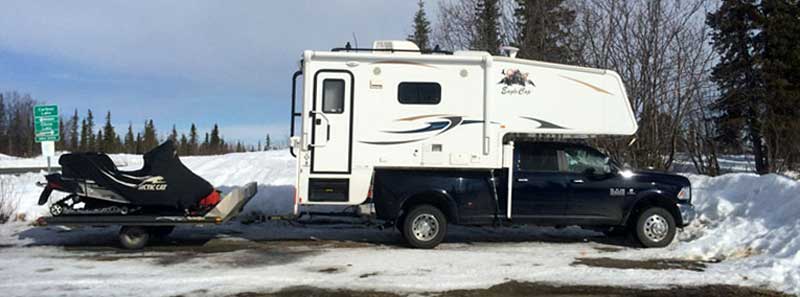
Above: Camping along Lake Louise road in the early spring to ice fish for lake trout
Does the extreme cold impact anything else in the camper?
Once it gets to temperature, the camper actually stays that way the entire time. We do turn it down at night to 60 for sleeping and bring it back up before coffee is ready in the morning. We also use really good sleeping bags.
We are both really pleased with the way the camper performs. We were both very comfortable and it was really cozy. We watched movies, ate really well and just enjoyed the quiet.
Being in such cold temperatures, we had an issue with the propane not flowing. We could barely get enough flame to make coffee. To solve this, I took hand warmers from Walmart and put them in a wool hat. I put the hat around the top of the propane tank and have never had another problem.
That’s a really neat idea. How long do the hand warmers last?
About 12 to 14 hours. The hand warmers provide enough heat at the valve for the propane to flow. The low propane flow has only happened a couple times. Wind may have been a factor.
“In the Upper Peninsula they call it a snowmobile. In Alaska, we call them snow machines. If you call it a snowmobile here, they laugh at you.”
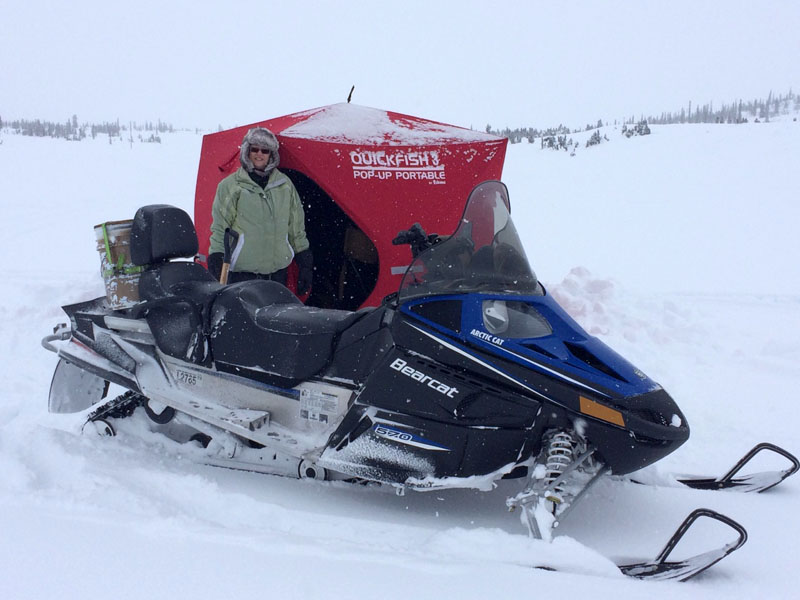
That’s some clever Alaskan ingenuity. It looks like you take your snowmobile to go ice fishing. Is that how you get to the good ice fishing locations?
That’s exactly what we do. In the Upper Peninsula they call it a snowmobile. In Alaska, we call them snow machines. If you call it a snowmobile here, they laugh at you.
I have a 10-foot snow machine trailer for our Arctic Cat Bearcat 570 snow machine, ice fishing sled and gear.
We’ll park the truck camper and trailer in a spot that’s plowed and off load the snow machine. There’s a place on Lake Louise that I can’t get to with the truck camper, so I’ll take a seven to eight mile ride on the snow machine to the lake.
We also bring along large sleds that are towed behind our snow machines. My heavy duty Otter plastic sled is modified so that the contents do not bounce around. All our gear fits in the sled.
Most utility snow machines, like the Bearcat 570, make wider tracks and have better floatation on deep snow. They are also made for towing.
I bring along fishing rods in a box with gear, a cooler with food and drinks, and maps. Everything goes in that box/tote. Everything else goes in the Otter sled. Otter sleds are designed to be towed behind a snow machine.
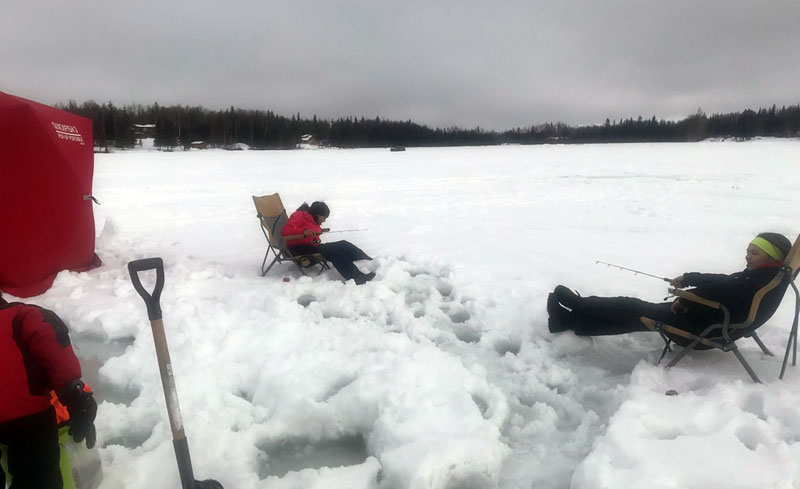
Above: Tom’s grandkids ice fishing
If there are three or four of us that go together, every one of us has our own Otter sled. You have to tow everything you bring along. Each person will have their own fishing shelter to set up as well.
There are lakes that are more remote where we can leave our shelters set up overnight if we’re going to stay two or three days. We usually go out after work on a Friday, get home and change clothes, hook up the trailer and go.
Then we’ll drag the sleds to the ice, set up shelters, set up the camper, and get it warm. Then we’ll have a few local brews and relax. The next day we have breakfast and go ice fishing.
“We love the feeling of getting outside in the cold. Inside the camper we are warm.”
Where do you live in Alaska to have this relatively local access to ice fishing opportunities?
We live in Big Lake, Alaska which is a very large lake and hosts ice fishing tournaments. I went to a tournament and it was like watching bass fishing tournaments. Instead of boats you’ll see snow machines.
There are big and elaborate sleds with rod holders, ice auger holders, ice shelters, and coolers. They have their logos on their snow machines. There was even a starting gun to start the tournament. The snow machines took off on the lake cruising at 60 to 80 miles per hour. Afterwards they had a fish weigh in.
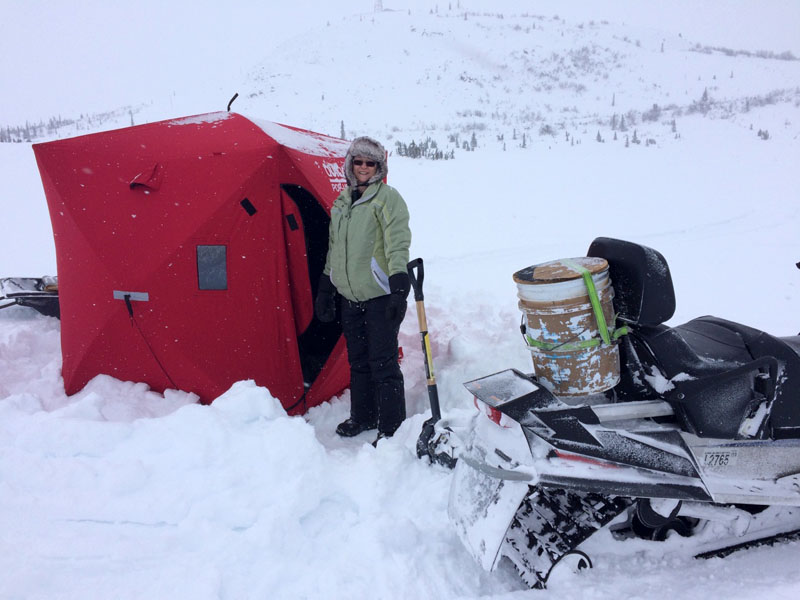
Does Doreen come along ice fishing with you?
Doreen will come along, but it’s when ice fishing isn’t the primary reason. In the picture you’ll see that I am in the shelter and that she kicks back and reads. She’s all bundled up out on the ice.
We love the feeling of getting outside in the cold. Inside the camper we are warm. We can watch television, have cell service, and watch Netflix. Alaska now is covering the gaps with cell phone coverage. I have AT&T, and usually have better service when we’re out in the camper than at our house.
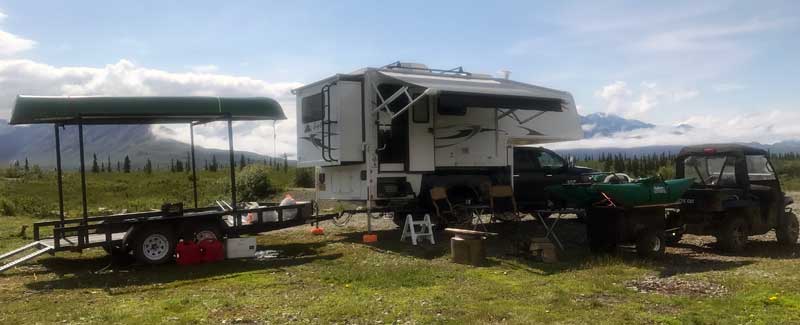
That’s incredible. We have long thought that cell service in Alaska must be horrible. That’s a no-go for our constant online magazine work.
One of the places we like to go is Knob Lake. That location has a cell tower at the top of the knob. We get the best reception there. If you know where those locations are, you can get close to them.
There’s a tower on the Richardson Highway near Paxton. If I get within eye shot, I’ve got awesome reception in the middle of nowhere.
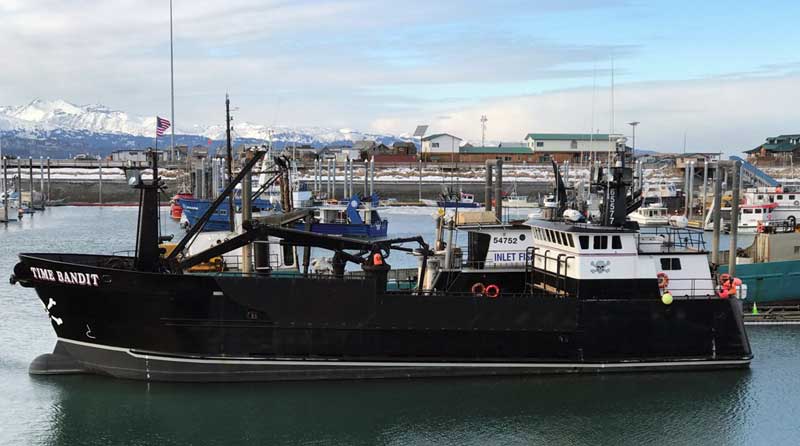
Above: Time Bandit from the Deadliest Catch TV series moored in the Homer Alaska boat harbor
So you need to know where the cell service is. That makes sense. For your Homer picture you describe fishing in the Homer Winter King Salmon Tournament. Tell us about participating in that fishing tournament.
Homer hosts a King Salmon fishing tournament each winter. When you live in Alaska you’ve got to have more than the summer time activities.
I have a buddy with a 35-foot charter boat. We take his boat and fish in that tournament. You pay to enter and then there are cool prizes. It’s very regimented. We call in every fish whenever our boat catches one. With King Salmon, we don’t catch a lot, but we do catch at least one or two for the boat.
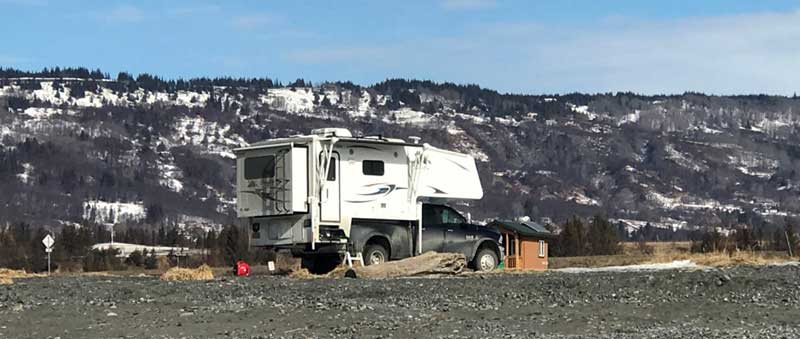
Above: Camping along the beach in Homer, Alaska
Homer fills up the hotels during the tournament, so we take our truck camper. During the tournament the RV lots open for electricity. It brings income to Homer in the winter. We were also fortunate because my grandson plays hockey and on that same weekend had a tournament in Homer.
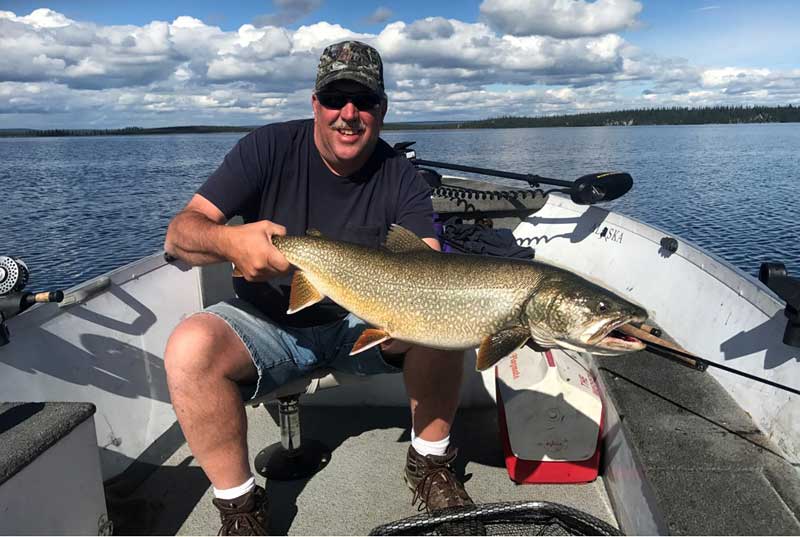
Above: Tom’s brother, Tim, visiting from Northern Michigan. He landed a lake trout on Lake Louise. Notice that there are no other boats in the background.
That was lucky, and a fantastic opportunity for the truck camper. Let’s rewind a little. Tell us the story of how you were first introduced to truck campers.
Doreen and I both grew up in Northern Michigan and camped with our families. For the most part it was tent camping but, as my parents got older, they went to a travel trailer.
Doreen and I were married in 1979. We had a Ford F250 single cab pick-up. We found a used topper that was much higher then the truck’s cab. It was insulated, offered storage, two bunks, a ceiling vent, and a short but regular door on the rear. The tailgate was removed. This was our camper that we traveled to the Upper Peninsula of Michigan on weekend trips. We could stay dry and away from the bugs.
We joined the Air Force in November of 1980, left the F250 behind, and we went back to tent camping. It was easier to move from station to station with tent camping gear. We had three girls and we raised them on tent camping.
In 1985 we were assigned to K. I. Sawyer AFB in the Upper Peninsula of Michigan. We camped a lot with a big tent and had all the gear to make for a nice campsite.
Then we experienced a pretty bad storm during one particular trip. We got drenched. The tent was leaking and the floor had a moat of water around our sleeping bags. We ended up packing up and leaving. As we were about to leave, I noticed the RV campers were all going about their normal campsite routine.
It was then I knew we had to make a change. We ended up finding a nice pop-up tent trailer. It was up and off the ground and easy to tow, but it still felt like camping in a tent. After a couple overseas assignments and deployments, we were stationed at Castle AFB (now closed) in Atwater, California. We wanted to get back into the camping scene, so we ended up buying a 24-foot Wilderness Yukon travel trailer. The Yukon was nice. It was perfect for our girls, a dog, and a cat. We enjoyed that form of camping.
We were then assigned to North Carolina. Since we already had to travel across the country, we took the opportunity for an extended family vacation. We packed up the Yukon and traveled to Yellowstone National Park, Mount Rushmore, Jefferson City, Missouri to see friends, to Northern Michigan to see family, and then to North Carolina.
We spent seven years in North Carolina and camped all over that area with the Yukon. In 1999, we were assigned to Anchorage, Alaska. At the time I had the Yukon and a fishing boat. I really wanted to take the boat up to Alaska, but could not tow both.
We put the boat and camper up for sale. Whichever one we sold first we would keep the other. If the camper were to sell we would by a truck camper and tow the boat. The boat sold, so we took the Yukon up to Alaska via the Alaska Highway. That trip was great. We have awesome memories.
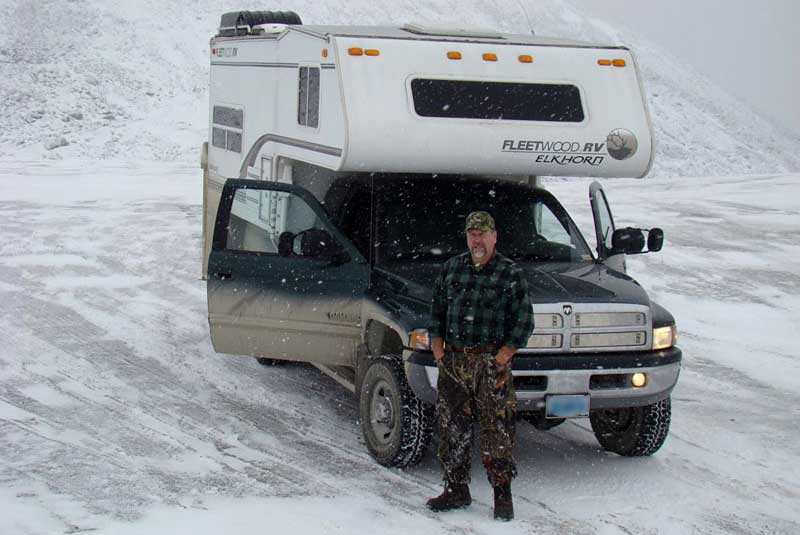
Above: Along the Dalton Highway north of Fairbanks at the top of Atigun Pass.
Once we settled in Alaska, the girls were older and pretty much doing their own thing. Doreen and I were ready to part with the Yukon. We wanted a truck camper because we wanted to be able to tow.
We started looking and found a 2001 Fleetwood Elkhorn wet bath. We had also purchased a new Dodge 2500 diesel. It was the perfect combination. There was no added suspension equipment needed. Having this truck camper combination convinced us that this was the RV type for us. We absolutely loved it.
We put a little over 300,000 miles on that rig just here in Alaska. The truck was my daily driver as well. As we camped more we decided we wanted a bit more space, but still wanted a truck camper.
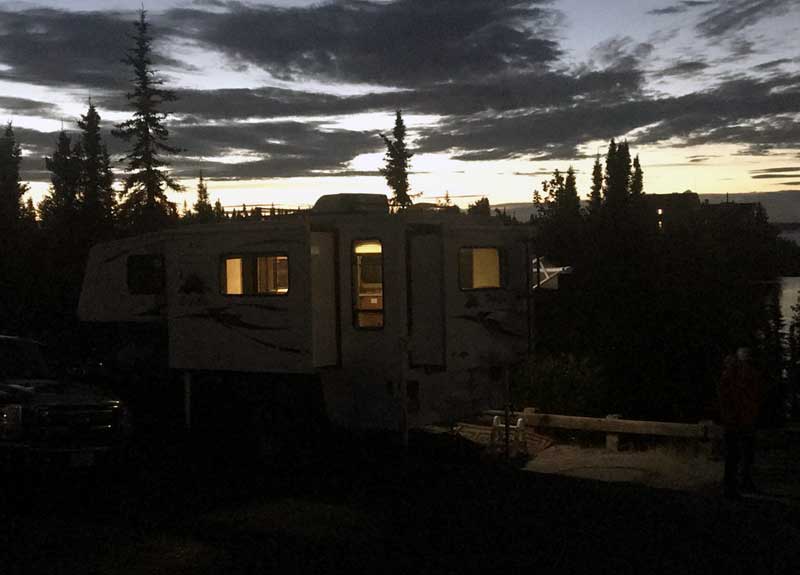
Above: An evening shot in the Alaska State forest campground at Lake Louise.
Truck Camper Magazine introduced us to Eagle Cap as well as many other campers. We decided the Eagle Cap 1160 was the one for us. We had to do a two day drive from Anchorage to Whitehorse in the Yukon Territories to purchase the Eagle Cap. There are no dealers here, so we could not get an Eagle Cap in Alaska.
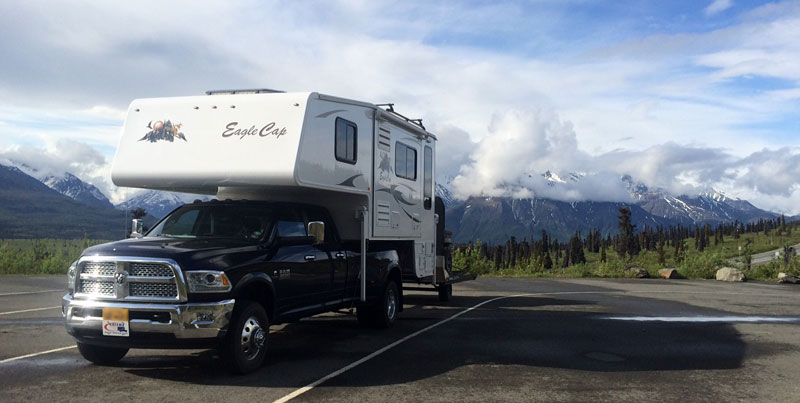
Above: Going on a fishing expedition 200 miles north of Anchorage.
In April of 2014, Doreen and I took a week off and went to Whitehorse to pick up the camper. We are very happy with the Eagle Cap 1160. It is everything we hoped it would be for us. It provides us with ample living space, additional storage and a dry bath. The slides really open up the living space and the combination with the Ram 3500 dually allows us to tow all of our toys all season long.
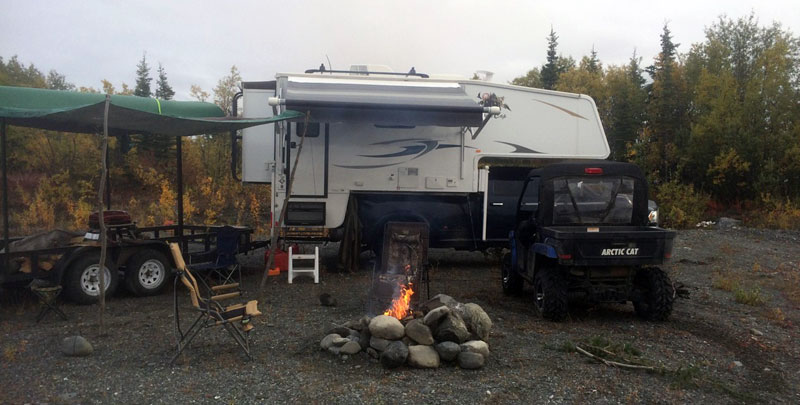
Above: Camping along the Lake Louise road
Other than the winter fishing tournament in Homer, are you mostly dry camping in the Eagle Cap?
Yes, most time we are dry camping. Very seldom do we go to an RV park.
We utilize state forest campgrounds. There is one on the shore of Lake Louise. I have 50 gallons of fresh water in my Eagle Cap 1160. We’ll take four day weekends up to Lake Louise and we’re good with our tanks.
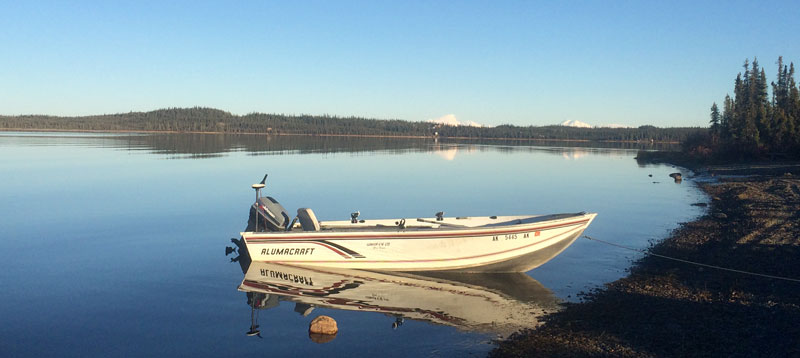
We already know you tow snow machines. So what other toys do you tow with the Eagle Cap truck camper rig?
We tow a 17-foot Alumacraft boat with a 40-horsepower four-stroke outboard. We also tow a 20-foot twin axle cargo trailer with our Arctic Cat Prowler side-by-side.
I tow a small ATV trailer that carries my one-person pontoon boat. With that I fish in remote lakes and streams where very few fishermen go.
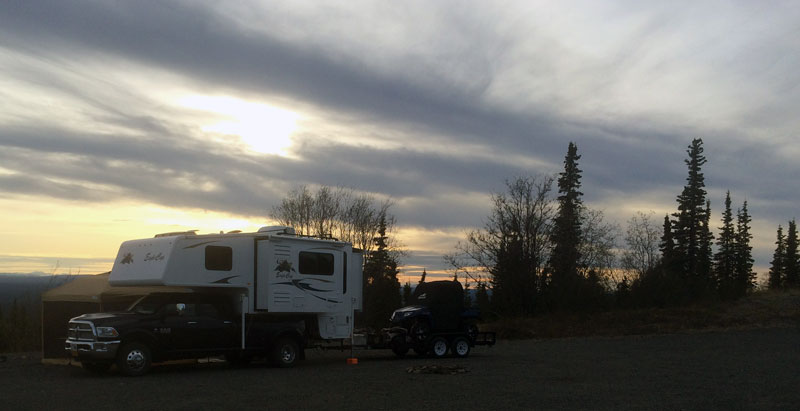
Above: Gravel pit off of Lake Louise Road, in Knob Lake, Alaska
We like to get out about every weekend in the summer. Since it’s just a weekend, we can’t go really far. Lake Louise is 170-miles north of Anchorage, so that’s a three hour drive one way. That’s usually what we do.
Where do you go with the side-by-side?
We’ll take the side-by-side on two-track roads near Lake Louise. The trails lead to remote lakes. We get back to those locations and we are the only ones there. It’s great because the fish are hungry. We’ve caught so many fish there. It’s awesome!
We’ll plan ahead with friends and go to Nelchina Glacier. We’ll get there on a Friday night, relax, have some beers, and have dinner. On Saturday, we’ll get up early, get on the side-by-sides and take trails to the glaciers and hang out.
We usually take different trails every time we go. We’ll find old miners’ cabins, blueberries, and even go gold panning. One of us will have an idea and we’ll go in that direction.
“We like to go to Portage Valley along the Seward Highway. There are six glaciers that you can see from that spot.”
Do you ever find any gold?
No we haven’t, yet. But in our minds, we are always thinking there’s a chance to find that one monster nugget that will allow us to retire and camp full time. Gold panning is fun and something we do for recreation, but it is not one of our primary activities.
Are there any other favorite Alaskan spots for your truck camping adventures?
We like to go to Portage Valley along the Seward Highway. That’s Doreen’s favorite place. It’s an awesome place to take a truck camper. There are six glaciers that you can see from that spot.
We’ll set up a spotting scope, watch the bears, and relax. Then, we’ll go into Whittier to eat, go through the tunnel, and find a camping spot. We’ll come back to our house on Sunday afternoon.
Another thing Doreen and I love to do is cook big meals while camping. We’ll plan at least one day of our trip with an awesome meal.
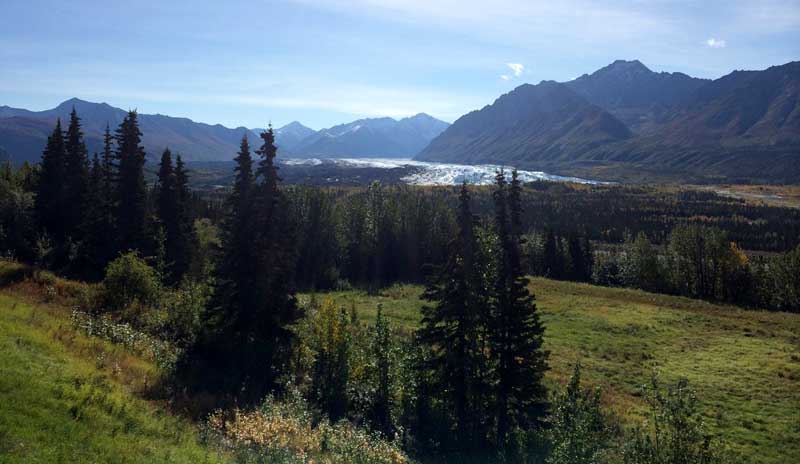
Above: Views of the Matanuska Glacier from the dining room of the Long Rifle Lodge. Doreen and Tom always plan trips with a stop here for lunch or dinner.
Tell us about how you use your truck camper for work.
We live an hour from the base. Due to the long commute time, we use the camper when I have extended work hours.
There are times my job requires me to be at work for 12 to 14 hours a day. At the end of the day we don’t want to do the commute. So we park in the parking lot and stay there. They have a campground, so we could stay there as well.
Our truck camper is like our moving hotel room. I have to go on a business trip next week out of state. Doreen does not like to do the commute alone, so she stays in the camper on base while I’m away.
If I lived in a warmer southern state we’d live in the camper more because it’s so versatile. Our kids are well established with families and they’re looking at campers. The truck camper may be best for them. I’m growing the community.
Tom and Doreen Warren’s Rig
Truck: 2013 Ram 3500, Crew Cab, 4X4, dually, diesel, long bed
Camper: 2013 Eagle Cap 1160
Tie-Downs and Turnbuckles: Torklift frame mounted tie downs, Torklift Fastguns
Suspension: Lower Torklift Stable Load, Firestone airbags
























